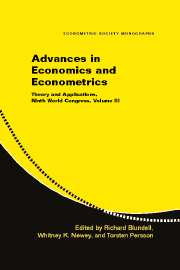Book contents
- Frontmatter
- Contents
- Contributors
- Introduction by the Editors
- 1 Identification of Nonadditive Structural Functions
- 2 Nonadditive Models with Endogenous Regressors
- 3 Heterogeneity and Microeconometrics Modeling
- 4 Heterogeneous Choice
- 5 Modeling Heterogeneity
- 6 Inference with Weak Instruments
- 7 Empirical Likelihood Methods in Econometrics: Theory and Practice
- 8 Weak Instruments and Empirical Likelihood: A Discussion of the Papers by D. W. K. Andrews, J. H. Stock, and Y. Kitamura
- 9 Estimating Continuous-Time Models with Discretely Sampled Data
- 10 Variation, Jumps, and High-Frequency Data in Financial Econometrics
- 11 Discussion of Aït-Sahalia and Barndorff-Nielsen and Shephard
- 12 Understanding Bias in Nonlinear Panel Models: Some Recent Developments
- 13 Fixed and Random Effects in Nonlinear Panel Data Model: A Discussion of a Paper by Manuel Arellano and Jinyong Hahn
- Index
- Titles in the series
6 - Inference with Weak Instruments
Published online by Cambridge University Press: 05 January 2013
- Frontmatter
- Contents
- Contributors
- Introduction by the Editors
- 1 Identification of Nonadditive Structural Functions
- 2 Nonadditive Models with Endogenous Regressors
- 3 Heterogeneity and Microeconometrics Modeling
- 4 Heterogeneous Choice
- 5 Modeling Heterogeneity
- 6 Inference with Weak Instruments
- 7 Empirical Likelihood Methods in Econometrics: Theory and Practice
- 8 Weak Instruments and Empirical Likelihood: A Discussion of the Papers by D. W. K. Andrews, J. H. Stock, and Y. Kitamura
- 9 Estimating Continuous-Time Models with Discretely Sampled Data
- 10 Variation, Jumps, and High-Frequency Data in Financial Econometrics
- 11 Discussion of Aït-Sahalia and Barndorff-Nielsen and Shephard
- 12 Understanding Bias in Nonlinear Panel Models: Some Recent Developments
- 13 Fixed and Random Effects in Nonlinear Panel Data Model: A Discussion of a Paper by Manuel Arellano and Jinyong Hahn
- Index
- Titles in the series
Summary
Abstract: The standard approach to reporting empirical results in economics is to provide point estimates and standard errors. With this information, confidence intervals (CIs) and tests are constructed using t tests and the normal critical values. In instrumental variables (IVs) regression with weak IVs, this approach is problematic. The most widely used estimator, two-stage least squares (2SLS), has significant bias and is poorly approximated by a normal distribution when IVs are weak and the degree of endogeneity is medium to strong. In fact, when the parameter space allows for arbitrarily weak IVs the exact finite-sample level of standard CIs of the form “estimate ± std error × constant” is zero and t tests have level one.
This paper reviews recent results in the literature on weak IVs that develop an alternative approach to inference with weak IVs. With this approach, one reports point estimates accompanied by CIs or tests that have levels that are robust to the strength of the IVs. In particular, CIs are formed by inverting tests that are robust to weak IVs. That is, a CI for a parameter β, say, is the set of points β0 for which a weak IV robust test fails to reject the null hypothesis H0: β = β0. This is the same method that is used to generate a CI of the form “estimate ± std error × constant” except that the test employed is one whose level is robust to weak IVs, rather than a t test based on a normal approximation.
- Type
- Chapter
- Information
- Advances in Economics and EconometricsTheory and Applications, Ninth World Congress, pp. 122 - 173Publisher: Cambridge University PressPrint publication year: 2007
- 15
- Cited by

